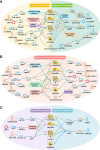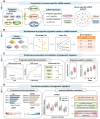Prognostic Roles of ceRNA Network-Based Signatures in Gastrointestinal Cancers
- PMID: 35924172
- PMCID: PMC9339642
- DOI: 10.3389/fonc.2022.921194
Prognostic Roles of ceRNA Network-Based Signatures in Gastrointestinal Cancers
Abstract
Gastrointestinal cancers (GICs) are high-incidence malignant tumors that seriously threaten human health around the world. Their complexity and heterogeneity make the classic staging system insufficient to guide patient management. Recently, competing endogenous RNA (ceRNA) interactions that closely link the function of protein-coding RNAs with that of non-coding RNAs, such as long non-coding RNA (lncRNA) and circular RNA (circRNA), has emerged as a novel molecular mechanism influencing miRNA-mediated gene regulation. Especially, ceRNA networks have proven to be powerful tools for deciphering cancer mechanisms and predicting therapeutic responses at the system level. Moreover, abnormal gene expression is one of the critical breaking events that disturb the stability of ceRNA network, highlighting the role of molecular biomarkers in optimizing cancer management and treatment. Therefore, developing prognostic signatures based on cancer-specific ceRNA network is of great significance for predicting clinical outcome or chemotherapy benefits of GIC patients. We herein introduce the current frontiers of ceRNA crosstalk in relation to their pathological implications and translational potentials in GICs, review the current researches on the prognostic signatures based on lncRNA or circRNA-mediated ceRNA networks in GICs, and highlight the translational implications of ceRNA signatures for GICs management. Furthermore, we summarize the computational approaches for establishing ceRNA network-based prognostic signatures, providing important clues for deciphering GIC biomarkers.
Keywords: ceRNA network; circRNA; gastrointestinal cancer; lncRNA; prognostic signature; translational implication.
Copyright © 2022 Qi, Chen, Zhao, Chen, Niu and Shen.
Conflict of interest statement
The authors declare that the research was conducted in the absence of any commercial or financial relationships that could be construed as a potential conflict of interest.
Figures


Similar articles
-
Systematic analysis of lncRNA-miRNA-mRNA competing endogenous RNA network identifies four-lncRNA signature as a prognostic biomarker for breast cancer.J Transl Med. 2018 Sep 27;16(1):264. doi: 10.1186/s12967-018-1640-2. J Transl Med. 2018. PMID: 30261893 Free PMC article.
-
Identification of circRNA-lncRNA-miRNA-mRNA Competitive Endogenous RNA Network as Novel Prognostic Markers for Acute Myeloid Leukemia.Genes (Basel). 2020 Jul 31;11(8):868. doi: 10.3390/genes11080868. Genes (Basel). 2020. PMID: 32751923 Free PMC article.
-
Construction of a circRNA-Related ceRNA Prognostic Regulatory Network in Breast Cancer.Onco Targets Ther. 2020 Aug 20;13:8347-8358. doi: 10.2147/OTT.S266507. eCollection 2020. Onco Targets Ther. 2020. PMID: 32922032 Free PMC article.
-
Decoding competing endogenous RNA networks for cancer biomarker discovery.Brief Bioinform. 2020 Mar 23;21(2):441-457. doi: 10.1093/bib/bbz006. Brief Bioinform. 2020. PMID: 30715152 Review.
-
Competitive endogenous RNA network: potential implication for systemic lupus erythematosus.Expert Opin Ther Targets. 2017 Jun;21(6):639-648. doi: 10.1080/14728222.2017.1319938. Epub 2017 Apr 23. Expert Opin Ther Targets. 2017. PMID: 28406715 Review.
Cited by
-
Bioinformatics Analysis and Validation of Potential Markers Associated with Prediction and Prognosis of Gastric Cancer.Int J Mol Sci. 2024 May 28;25(11):5880. doi: 10.3390/ijms25115880. Int J Mol Sci. 2024. PMID: 38892067 Free PMC article. Review.
-
Cell Cycle-Based Molecular Features via Synthetic Lethality and Non-Coding RNA Interactions in Cancer.Genes (Basel). 2025 Mar 5;16(3):310. doi: 10.3390/genes16030310. Genes (Basel). 2025. PMID: 40149461 Free PMC article.
-
Comprehensive analysis of the LINC01122/TPD52 axis as a predictive biomarker in prostate adenocarcinoma.Sci Rep. 2025 May 8;15(1):16122. doi: 10.1038/s41598-025-98219-1. Sci Rep. 2025. PMID: 40341647 Free PMC article.
-
Research progress on microRNA-1258 in the development of human cancer.Front Oncol. 2022 Sep 29;12:1024234. doi: 10.3389/fonc.2022.1024234. eCollection 2022. Front Oncol. 2022. PMID: 36249037 Free PMC article. Review.
-
Circ_0000182 promotes cholesterol synthesis and proliferation of stomach adenocarcinoma cells by targeting miR-579-3p/SQLE axis.Discov Oncol. 2023 Feb 20;14(1):22. doi: 10.1007/s12672-023-00630-5. Discov Oncol. 2023. PMID: 36808302 Free PMC article.
References
Publication types
LinkOut - more resources
Full Text Sources

